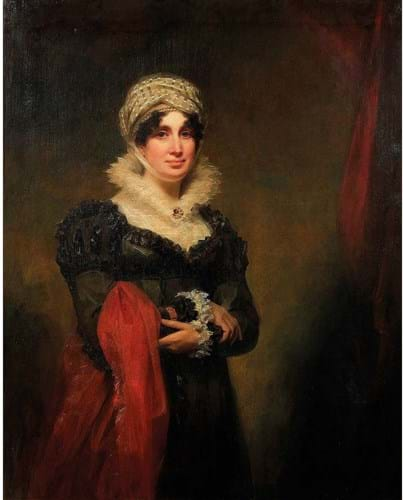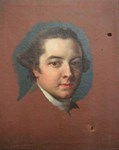Although the overall market for Scottish art remains fairly selective, it is not hard to find examples of both 20th century works and earlier pictures selling well at recent auctions both north and south of the boarder.
The old adage that quality material will do well wherever it is offered has remained largely true throughout the pandemic, and the post-lockdown sales that have taken place since April have experienced a decent supply coming forward.
Scarce on the market
Among the most notable lots on offer in recent months was a three-quarter-length portrait by Sir Henry Raeburn (1756-1823) depicting Lady Agnes Carnegie (1763-1860) that appeared at Lyon Turnbull’s (25% buyer’s premium) Scottish Paintings & Sculpture sale in Edinburgh on June 10.
L&T specialists Nick Curnow and Charlotte Riordan believed this was one of the most important works by Raeburn to appear at auction in the last five years. With many of his major portraits now in public collections, significant examples such as this have become scarce on the market.
The 4ft 2in x 3ft 4in (1.27 x 1.02m) oil on canvas was a significant commission from c.1810 when Raeburn was at the height of his powers. The elegantly dressed sitter was born in Edinburgh in 1763 and raised in colonial America where her father, Andrew Elliot, was the last governor of New York. She returned with her family to Scotland in 1783 following American independence.
She subsequently married Sir David Carnegie, MP for Kincardineshire and deputy governor of the British Linen Company (seemingly no relation of the Scottish-American industrialist and philanthropist Andrew Carnegie who founded Carnegie Hall in New York). The couple had 12 children and lived between Kinnaird Castle and their house in Gloucester Place, London.
This portrait had passed to their daughter Madeline Carnegie and her politician husband Sir Andrew Agnew. Having subsequently left the family, it came to auction from the descendants of John Reid (1861-1933), a son of James Reid of
In terms of its artistic merit this picture also ranked highly. With a subtle palette, Lady Carnegie is shown looking towards the viewer with a soft, smiling poise, and the light playing on the stripes of her ivory headdress. The amount of labour involved in the painting indicates it was clearly a major commission for Raeburn, as opposed to some of his more workaday portraits that emerge more commonly at auction.
The combined factors of its quality of execution, the interesting and attractive sitter, excellent provenance and a long exhibition history (not to mention its good condition for its age) meant that it was a valuable commercial proposition.
Estimated at £15,000-20,000, it drew substantial interest from private buyers and was knocked down to one of their number from the US at £80,000. L&T said this was the latest example of increasing interest from the US that it had experienced over the last 18 months.
In terms of Raeburn prices, it was the sixth highest overall (the record stands at £380,000 for a portrait of Sir Evan Murray-MacGregor of MacGregor sold at Christie’s in July 2014), but it was the highest sum fetched for a Raeburn sold in Scotland (source: Artprice by Artmarket). It was also the top lot of the L&T sale.
Rare Stronach
Another picture making a rare auction appearance was an oil painting by the mural specialist and portraitist Ancell Stronach (1901-81).
While he is less well known today, the Dundee-born artist was a significant figure in the Scottish art scene in the 1920s-30s, training at the Glasgow School of Art before becoming an expert church painter and stained glass designer, and rising to the position of professor of mural painting at Glasgow School of Art.
His works were exhibited internationally including in Paris, the US, Canada and New Zealand but, while three examples are known in public collections in the UK, only seven works by Stronach are recorded as ever having sold at auction.
The main reason is that his career as a professional painter and teacher was incredibly short - he gave it up, meaning his painted output is very limited.
At the outbreak of war in 1939, his life changed direction and he decided to pursue a long-standing interest in animals and the circus. He married a professional acrobat and they toured together with a show titled Ancell and his 40 Painted Pigeons.
He never re-engaged with the art world, although it is believed he continued to paint for personal pleasure.
The work at L&T was titled Where sinks the voice of music into silence and demonstrated his flair for religious subjects during the short time when he produced such paintings.
His technique was inspired by early Italian fresco painters as well as the Pre-Raphaelites with areas of rich, flat colour interspersed with delicate patterning and fine details imbuing the work with a high sense of mysticism and also giving it an overall effect that was in keeping with the wider Celtic Revival movement prevalent at the time.
While a similarly stylised painting titled Circe made £26,000 at Christie’s in September 2014 and another can be found in The City Art Centre in Edinburgh, L&T’s Curnow and Riordan believed such works are now as rare as hen’s teeth.
Furthermore, this 4ft 2in x 3ft 4in (1.27 x 1.02m) signed oil on canvas from 1924 was known to have been exhibited at The Royal Glasgow Institute of Fine Arts in the year it was painted.
Having been purchased by the vendor’s late husband from dealer The Fine Art Society in 1980, it was pitched here at £30,000-50,000 and again attracted keen bidding from private individuals, selling to one of them at £46,000 - a price raising Stronach to a new level. It will be interesting to see if this notable sum brings one or two other works by the artist out of the woodwork.
MacTaggart in demand
The L&T sale also featured six works by Sir William MacTaggart (1903-81)* that all sold above estimate, one substantially so. Consigned from four separate sources, they raised a combined £76,100.
While it has been some time since a major work has appeared at auction, the sale offered one of the artist’s earlier and more commercial examples from 1933. Depicting Palma in Majorca, it was an attractive subject that also had a prime provenance to boot, having never left the artist’s family and being consigned by one of MacTaggart’s descendants.
The 2ft x 20in (61 x 51cm) signed oil on board had the distinct feel of the works of John Maclauchlan Milne (1885-1957) - especially the sweeping coastal composition with a bright and vivid palette - and duly ended up making a price to match those normally associated with the latter.
Estimated at £4000-6000, it was knocked down at £34,000 to a private buyer and broke the £22,000 auction record for MacTaggart that had stood for over a decade.
Indeed, the strong performance of the MacTaggart works here would have given encouragement to the wider Scottish art market, belying the selectivity often associated with the sector.
* The artist is sometimes known as ‘Sir William MacTaggart the younger’ as he was the grandson of William McTaggart (1835-1910), one of Scotland’s most celebrated landscape painters.

















